Publications
2025
- Next Materials
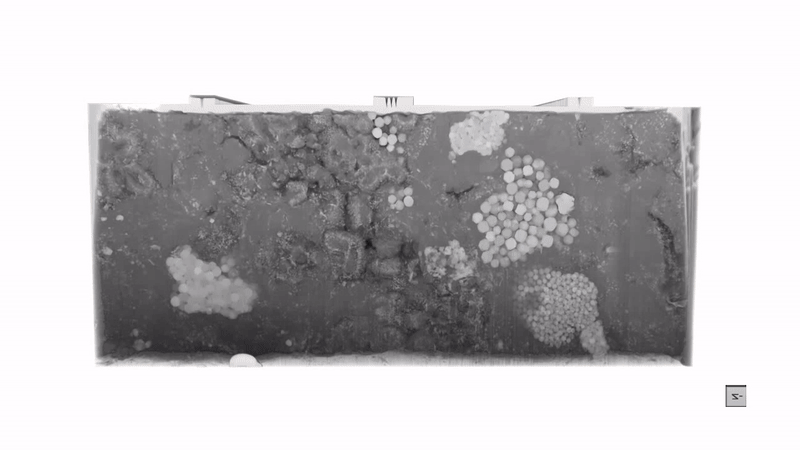 Efficient microstructure segmentation in three-dimensional imaging: Combining few-shot learning with the segment anything modelPo-Yen Tung*, and Richard J. HarrisonNext Materials, 2025
Efficient microstructure segmentation in three-dimensional imaging: Combining few-shot learning with the segment anything modelPo-Yen Tung*, and Richard J. HarrisonNext Materials, 2025The application of three-dimensional (3D) imaging techniques, such as X-ray tomography and focussed ion beam scanning electron microscopy (FIB-SEM), is increasingly widespread in microstructural analysis of natural materials. However, our ability to collect high-resolution tomographic datasets, each comprising thousands of two-dimensional (2D) images with millions of pixels, far outstrips our ability to analyse them. Pixel-level segmentation of each 2D image is the first step in any analysis pipeline, but creates a considerable human bottleneck in the workflow that can now be overcome using machine learning. Although advanced pre-trained models such as the Segment Anything Model (SAM) have emerged, conventional segmentation workflows for 3D tomographic data remain limited in comparison. To tackle this, we propose a machine learning workflow that combines SAM with a few-shot learning framework, automating segmentation and minimising user bias. Using SAM, we generate precise annotations from a limited subset of 2D images through basic input prompts, such as points and boxes. These annotations serve as the training data for the few-shot learning model. We benchmark this workflow using a complex 3D FIB-SEM tomographic dataset of the C2 ungrouped carbonaceous chondrite WIS91600. With only 0.6 % of the training data, our method achieves an intersection over union (IoU) score of 80.62 % compared to the ground truth, significantly outperforming widely used methods that achieve a maximum IoU score of 67.07 %. The strong performance on the challenging meteorite dataset highlights its potential for broader application across materials and imaging modalities.
- Mat. Charact.
 Effects of ausforming on the microstructure and stability of blocky austenite in nanostructured bainitePo-Yen Tung*, Shao-Pu Tsai, Yu-Ting Tsai, and Jer-Ren YangMaterials Characterization, 2025
Effects of ausforming on the microstructure and stability of blocky austenite in nanostructured bainitePo-Yen Tung*, Shao-Pu Tsai, Yu-Ting Tsai, and Jer-Ren YangMaterials Characterization, 2025Nanostructured bainitic steels exhibit high strength and toughness. A potential approach to improving their toughness is enhancing the chemical or mechanical stability of blocky austenite while maintaining the volume fractions of austenite and bainitic ferrite. This study investigates the effects of ausforming at 250 °C with a 20 % strain on the microstructure and stability of blocky austenite and contrasts these effects with non-ausformed bainite. The stability of austenite is assessed by cryogenic treatments. Two types of bainitic ferrite are observed in ausformed bainite. The fine bainitic ferrite forms around austenite twins and has the Kurdjumov-Sachs (K-S) orientation relationship with austenite. In contrast, the coarse bainitic ferrite, which has the Nishiyama-Wassermann (N-W) orientation relationship, creates an interlocking microstructure where blocky austenite is refined and has a high dislocation density. The blocky austenite in the ausformed bainite remains untransformed after the cryogenic treatment, while some blocky austenite in non-ausformed bainite transforms into martensite. These results suggest that two types of bainitic ferrite may form via different mechanisms, and that the interlocking microstructure enhances mechanical stability of blocky austenite by dislocations and block size refinement.
2024
- Under Review
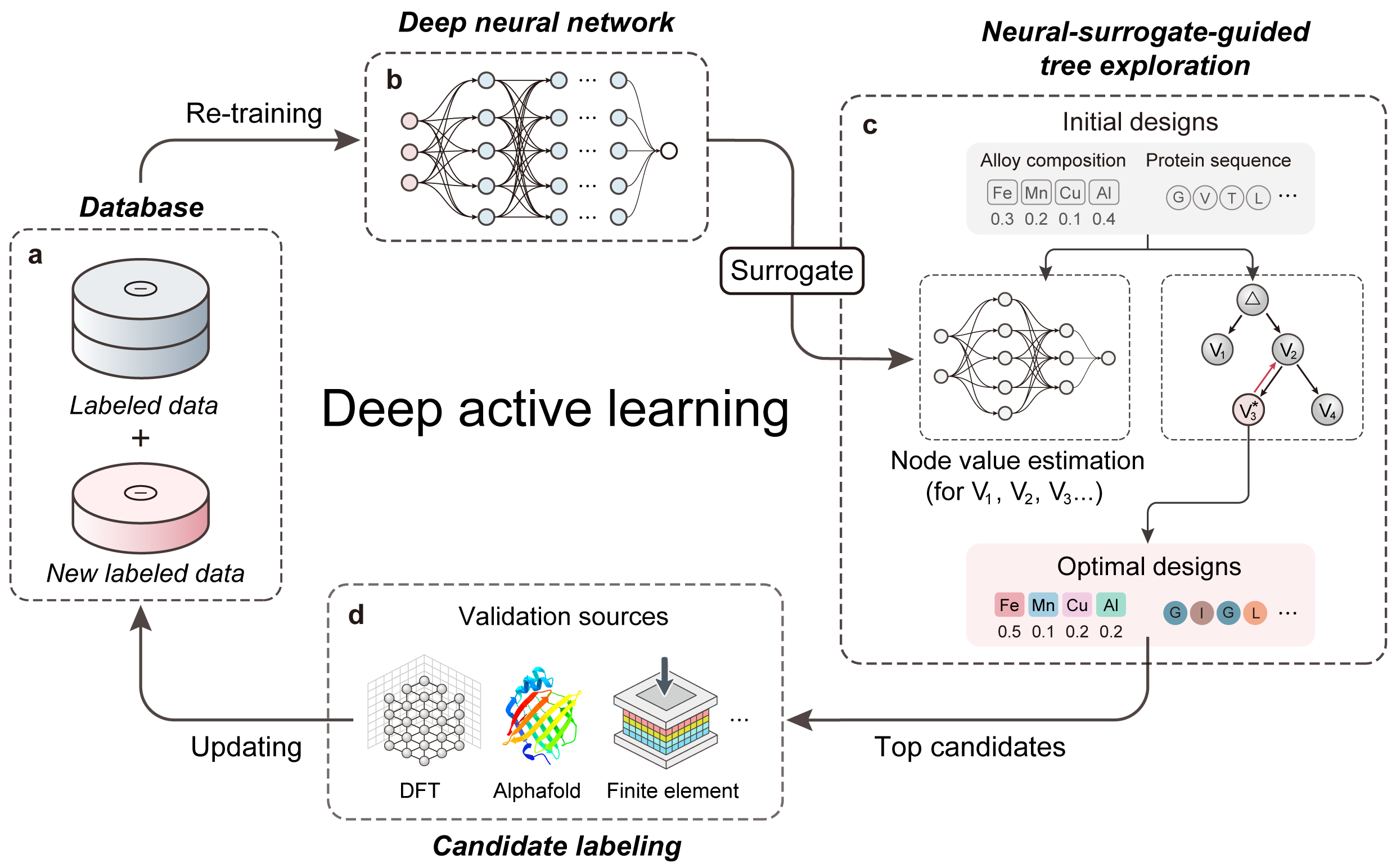 Deep active learning for complex systemsYe Wei*, Bo Peng*, Ruiwen Xie*, Yangtao Chen*, Yu Qin*, Peng Wen*, Stefan Bauer*, Po-Yen Tung*, and Dierk RaabeUnder review in Nature Computational Science, 2024
Deep active learning for complex systemsYe Wei*, Bo Peng*, Ruiwen Xie*, Yangtao Chen*, Yu Qin*, Peng Wen*, Stefan Bauer*, Po-Yen Tung*, and Dierk RaabeUnder review in Nature Computational Science, 2024Inferring optimal solutions from limited data is considered the ultimate goal in scientific discovery. Artificial intelligence offers a promising avenue to greatly accelerate this process. Existing methods often depend on large datasets, strong assumptions about objective functions, and classic machine learning techniques, restricting their effectiveness to low-dimensional or data-rich problems. We present a deep active learning pipeline that combines deep neural networks with a novel tree search to find superior solutions in high-dimensional complex problems with non-cumulative objectives and limited data availability. Our pipeline iteratively approaches the optimum using a neural surrogate and introduces new search mechanisms to bypass the local optimum and minimize the number of samples needed to achieve superior solutions. These contributions enable our pipeline to achieve superior solutions across diverse problems with up to 2,000 dimensions, whereas existing methods are limited to 100 dimensions and require up to 10 times more data points. Our pipeline demonstrates wide applicability, discovering superior solutions in various domain science problems. This advancement enables data-efficient knowledge discovery and opens the path towards scalable self-driving laboratories. Although we focus on problems within the realm of scientific domain, the advancements achieved herein are applicable to a broader spectrum of challenges across all quantitative disciplines.
- Science Adv.
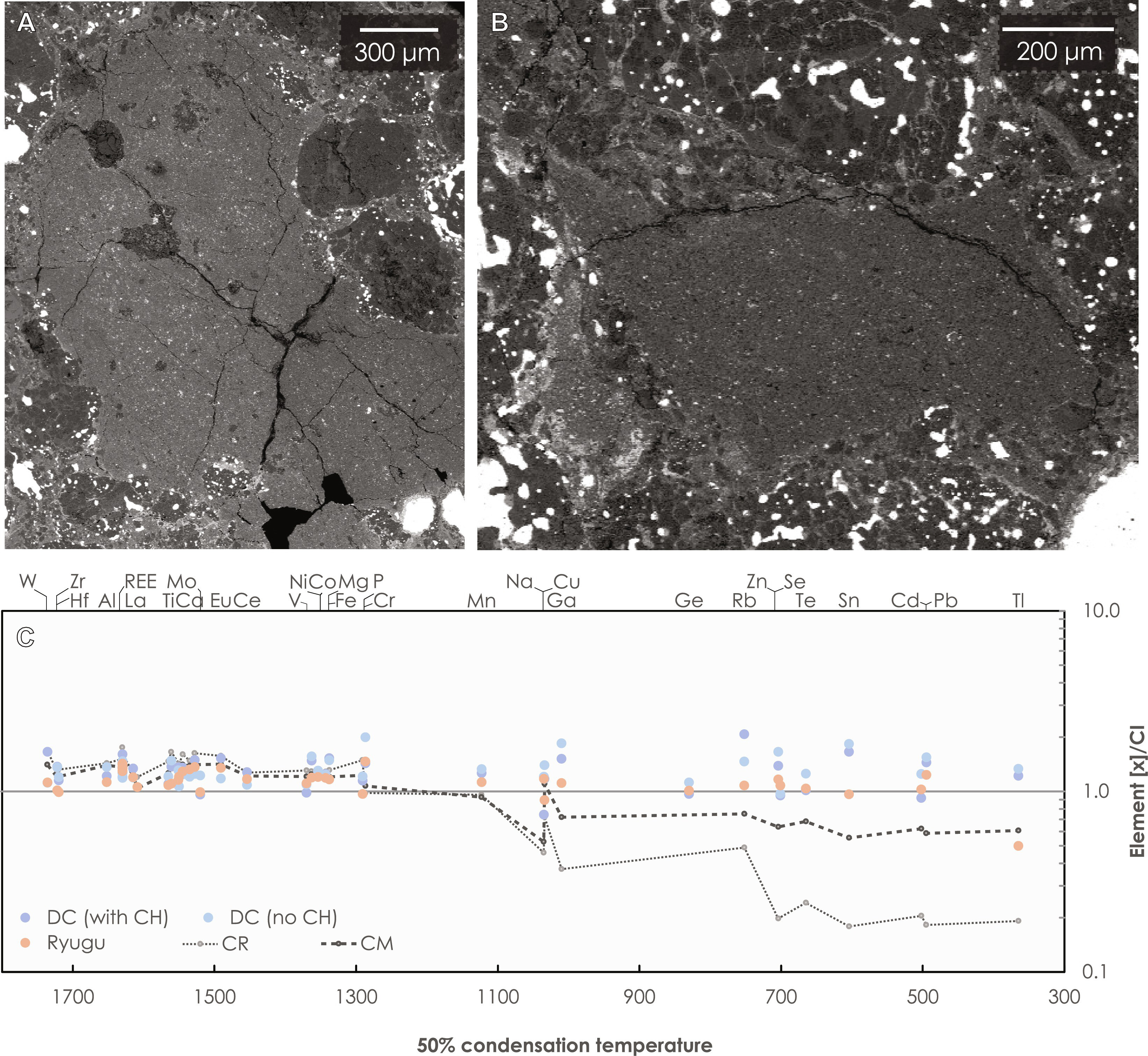 The nucleosynthetic fingerprint of the outermost protoplanetary disk and early Solar System dynamicsElishevah Kooten, Xuchao Zhao, Ian Franchi, Po-Yen Tung, Simon Fairclough, John Walmsley, Isaac Onyett, Martin Schiller, and Martin BizzarroScience Advances, 2024
The nucleosynthetic fingerprint of the outermost protoplanetary disk and early Solar System dynamicsElishevah Kooten, Xuchao Zhao, Ian Franchi, Po-Yen Tung, Simon Fairclough, John Walmsley, Isaac Onyett, Martin Schiller, and Martin BizzarroScience Advances, 2024Knowledge of the nucleosynthetic isotope composition of the outermost protoplanetary disk is critical to understand the formation and early dynamical evolution of the Solar System. We report the discovery of outer disk material preserved in a pristine meteorite based on its chemical composition, organic-rich petrology, and 15N-rich, deuterium-rich, and 16O-poor isotope signatures. We infer that this outer disk material originated in the comet-forming region. The nucleosynthetic Fe, Mg, Si, and Cr compositions of this material reveal that, contrary to current belief, the isotope signature of the comet-forming region is ubiquitous among outer Solar System bodies, possibly reflecting an important planetary building block in the outer Solar System. This nucleosynthetic component represents fresh material added to the outer disk by late accretion streamers connected to the ambient molecular cloud. Our results show that most Solar System carbonaceous asteroids accreted material from the comet-forming region, a signature lacking in the terrestrial planet region. The cometary nucleosynthetic component is ubiquitous among outer Solar System asteroids and planets.
-
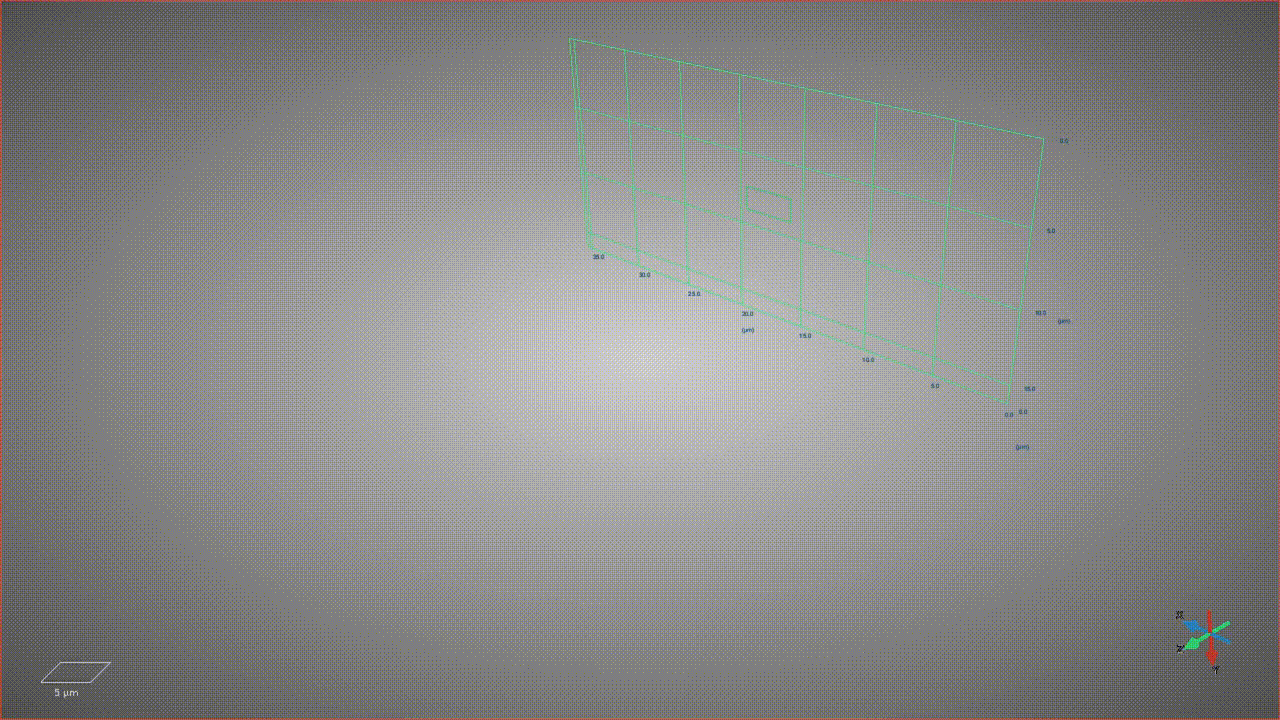 Investigation of high-temperature deformation behaviours of a low-carbon containing duplex stainless steelShao-Pu Tsai, Ming-Tai Hong, Wei-Hsun Lin, Ssu-Yun Lu, Yun-Rong Jiang, Te-Wei Lin, and Po-Yen TungJournal of Materials Research and Technology, 2024
Investigation of high-temperature deformation behaviours of a low-carbon containing duplex stainless steelShao-Pu Tsai, Ming-Tai Hong, Wei-Hsun Lin, Ssu-Yun Lu, Yun-Rong Jiang, Te-Wei Lin, and Po-Yen TungJournal of Materials Research and Technology, 2024To explore the optimal hot ductility regimes of a low-carbon bearing duplex stainless steel, we conducted tensile tests using a Gleeble 3500 simulator within a temperature range spanning from 900 °C to 1250 °C and a strain rate of 10 s−1, mimicking industrial conditions. Analysis of mechanical properties revealed the presence of three distinct zones, each intricately linked to microstructural variations. Employing thorough two-dimensional (2D) characterization enabled detailed crack analyses, unveiling a decrease in crack density with rising temperatures. Interestingly, precipitation effects only became prominent at higher temperatures, contrasting with δ/γ interface decohesion as the primary cause of cracking at lower temperatures. Subsequent three-dimensional (3D) analyses corroborated these observations. Large-area (>1 mm2) electron backscatter diffraction (EBSD) mappings, along with grain orientation spread (GOS) analyses, shed light on dynamic recrystallization (DRX) and dynamic recovery (DRV) mechanisms in both ferrite and austenite phases. Contrary to prevailing theories, our findings suggest the coexistence of DRX and DRV for both phases. Notably, at higher deformation temperatures, DRX prevails in both ferrite and austenite, whereas at lower temperatures, DRV becomes more dominant in austenite, leading to strain buildups in austenite and strain incompatibility between δ/γ interfaces. The identification of a critical temperature at 1100 °C underscores the vulnerability of δ/γ interfaces to crack formation, potentially compromising the material’s workability. These insights deepen our understanding of hot ductility behaviour in low-carbon bearing duplex stainless steel, offering valuable guidance for industrial applications and process optimization.
2023
-
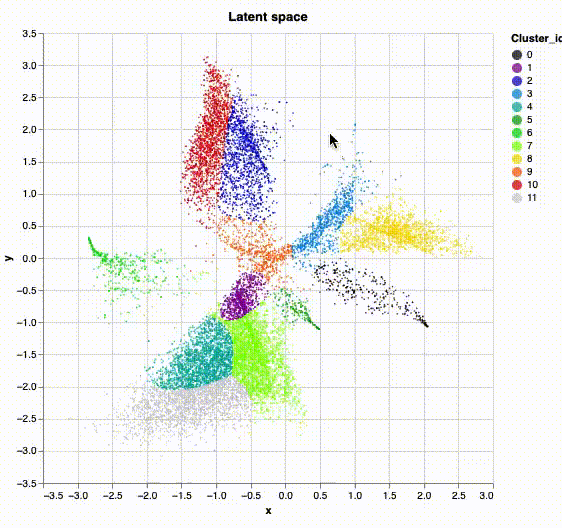 SIGMA: Spectral interpretation using gaussian mixtures and autoencoderPo-Yen Tung*, Hassan Sheikh, Matthew Ball, Farhang Nabiei, and Richard HarrisonGeochemistry, Geophysics, Geosystems, 2023
SIGMA: Spectral interpretation using gaussian mixtures and autoencoderPo-Yen Tung*, Hassan Sheikh, Matthew Ball, Farhang Nabiei, and Richard HarrisonGeochemistry, Geophysics, Geosystems, 2023Identification of unknown micro- and nano-sized mineral phases is commonly achieved by analyzing chemical maps generated from hyperspectral imaging data sets, particularly scanning electron microscope—energy dispersive X-ray spectroscopy (SEM-EDS). However, the accuracy and reliability of mineral identification are often limited by subjective human interpretation, non-ideal sample preparation, and the presence of mixed chemical signals generated within the electron-beam interaction volume. Machine learning has emerged as a powerful tool to overcome these problems. Here, we propose a machine-learning approach to identify unknown phases and unmix their overlapped chemical signals. This approach leverages the guidance of Gaussian mixture modeling clustering fitted on an informative latent space of pixel-wise elemental data points modeled using a neural network autoencoder, and unmixes the overlapped chemical signals of phases using non-negative matrix factorization. We evaluate the reliability and the accuracy of the new approach using two SEM-EDS data sets: a synthetic mixture sample and a real-world particulate matter sample. In the former, the proposed approach successfully identifies all major phases and extracts background-subtracted single-phase chemical signals. The unmixed chemical spectra show an average similarity of 83.0% with the ground truth spectra. In the second case, the approach demonstrates the ability to identify potentially magnetic Fe-bearing particles and their background-subtracted chemical signals. We demonstrate a flexible and adaptable approach that brings a significant improvement to mineralogical and chemical analysis in a fully automated manner. The proposed analysis process has been built into a user-friendly Python code with a graphical user interface for ease of use by general users.
- Efficacy of green infrastructure in reducing exposure to local, traffic-related sources of airborne particulate matter (PM)Hassan Aftab Sheikh, Barbara A Maher, Andy W Woods, Po-Yen Tung, and Richard J HarrisonScience of the Total Environment, 2023
One aim of roadside green infrastructure (GI) is to mitigate exposure to local, traffic-generated pollutants. Here, we determine the efficacy of roadside GI in improving local air quality through the deposition and/or dispersion of airborne particulate matter (PM). PM was collected on both pumped air filters and on the leaves of a recently installed ‘tredge’ (trees managed as a head-high hedge) at an open road environment next to a primary school in Manchester, U.K. The magnetic properties of PM deposited on leaves and filters (size fractions PM10 and PM2.5) were deduced from hysteresis loops, first-order reversal curves (FORCs), and low-temperature remanence measurements. These were complemented with electron microscopy to identify changes in magnetic PM concentration downwind of the tredge/GI. We show that the tredge is permeable to airflow using a simple CO2 tracer experiment; hence, it allows interception and subsequent deposition of PM on its leaves. Magnetic loadings per m3 of air from filters (PM10 saturation magnetisation, Ms, at 5 K) were reduced by 40 % behind the tredge and a further 63 % in the playground; a total reduction of 78 % compared to roadside air. For the PM2.5 fraction, the reduction in magnetic loading behind the tredge was remarkable (82 %), reflecting efficient diffusional capture of sub-5 nm Fe-oxide particles by the tredge. Some direct mixing of roadside and playground air occurs at the back of the playground, caused by air flow over, and/or through gaps in, the slowly-permeable tredge. The magnetic loading on tredge leaves increased over successive days, capturing 23 % of local, traffic-derived PM10. Using a heuristic two-dimensional turbulent mixing model, we assess the limited dispersion of PM < 22.5 μm induced by eddies in the tredge wake. This study demonstrates that PM deposition on leaves reduces exposure significantly in this school playground setting; hence, providing a cost-effective mitigation strategy.
2022
- Science
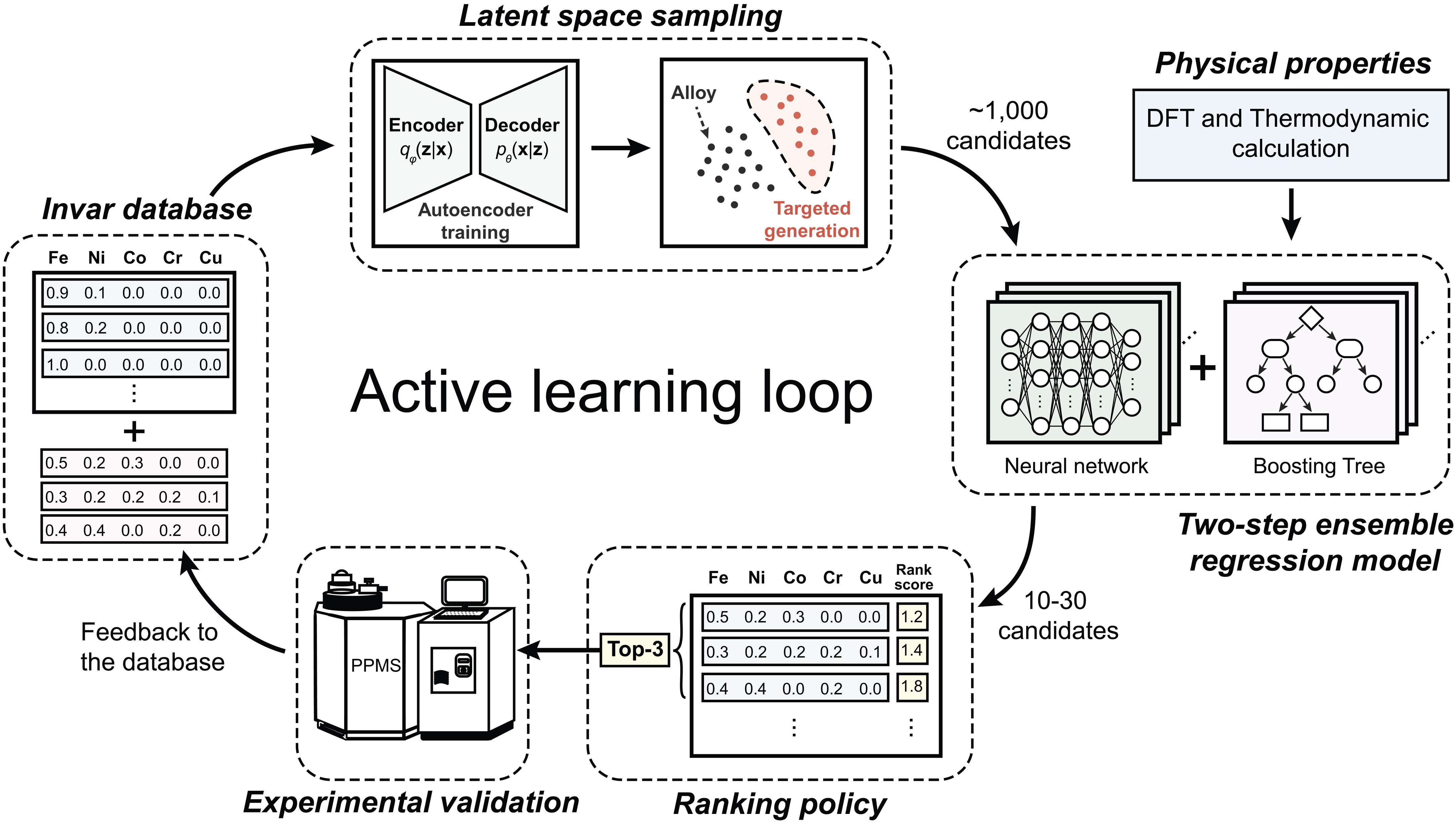 Machine learning–enabled high-entropy alloy discoveryZiyuan Rao, Po-Yen Tung, Ruiwen Xie, Ye Wei, Hongbin Zhang, Alberto Ferrari, TPC Klaver, Fritz Körmann, Prithiv Thoudden Sukumar, Alisson Silva, and othersScience, 2022
Machine learning–enabled high-entropy alloy discoveryZiyuan Rao, Po-Yen Tung, Ruiwen Xie, Ye Wei, Hongbin Zhang, Alberto Ferrari, TPC Klaver, Fritz Körmann, Prithiv Thoudden Sukumar, Alisson Silva, and othersScience, 2022High-entropy alloys are solid solutions of multiple principal elements that are capable of reaching composition and property regimes inaccessible for dilute materials. Discovering those with valuable properties, however, too often relies on serendipity, because thermodynamic alloy design rules alone often fail in high-dimensional composition spaces. We propose an active learning strategy to accelerate the design of high-entropy Invar alloys in a practically infinite compositional space based on very sparse data. Our approach works as a closed-loop, integrating machine learning with density-functional theory, thermodynamic calculations, and experiments. After processing and characterizing 17 new alloys out of millions of possible compositions, we identified two high-entropy Invar alloys with extremely low thermal expansion coefficients around 2 × 10−6 per degree kelvin at 300 kelvin. We believe this to be a suitable pathway for the fast and automated discovery of high-entropy alloys with optimal thermal, magnetic, and electrical properties.
- Magnetic and microscopic investigation of airborne iron oxide nanoparticles in the London UndergroundHA Sheikh, Po-Yen Tung, Emilie Ringe, and RJ HarrisonScientific Reports, 2022
Particulate matter (PM) concentration levels in the London Underground (LU) are higher than London background levels and beyond World Health Organization (WHO) defined limits. Wheel, track, and brake abrasion are the primary sources of particulate matter, producing predominantly Fe-rich particles that make the LU microenvironment particularly well suited to study using environmental magnetism. Here we combine magnetic properties, high-resolution electron microscopy, and electron tomography to characterize the structure, chemistry, and morphometric properties of LU particles in three dimensions with nanoscale resolution. Our findings show that LU PM is dominated by 5–500 nm particles of maghemite, occurring as 0.1–2 μm aggregated clusters, skewing the size-fractioned concentration of PM artificially to larger sizes when measured with traditional monitors. Magnetic properties are largely independent of the PM filter size (PM10, PM4, and PM2.5), and demonstrate the presence of superparamagnetic (< 30 nm), single-domain (30–70 nm), and vortex/pseudo-single domain (70–700 nm) signals only (i.e., no multi-domain particles > 1 µm). The oxidized nature of the particles suggests that PM exposure in the LU is dominated by resuspension of aged dust particles relative to freshly abraded, metallic particles from the wheel/track/brake system, suggesting that periodic removal of accumulated dust from underground tunnels might provide a cost-effective strategy for reducing exposure. The abundance of ultrafine particles identified here could have particularly adverse health impacts as their smaller size makes it possible to pass from lungs to the blood stream. Magnetic methods are shown to provide an accurate assessment of ultrafine PM characteristics, providing a robust route to monitoring, and potentially mitigating this hazard.
- Formation mechanism of brown etching layers in pearlitic rail steelPo-Yen Tung, Xuyang Zhou, Lutz Morsdorf, and Michael HerbigMaterialia, 2022
The formation of White Etching Layers (WELs) in rails can lead to the initiation of microcracks, thus reducing the service time of rails. However, the WEL formation mechanism is not yet understood. Brown Etching Layers (BELs) are the intermediate microstructure located between parent pearlite and WEL. In this work, we use BELs as a microstructural tracer to understand the early stages of WEL formation. We study the formation mechanisms of BELs in an industrial R350HT rail steel retrieved from a service application. Atom probe tomography, complementary transmission electron microscopy, and transmission Kikuchi diffraction provide us access to high resolution microstructure characterization. Carbon-depleted cementite lamellae are sheared and cut by dislocations. Several BEL areas with cementite particles exist in the direct vicinity of parent pearlite. Energy dispersive X-ray spectroscopy reveals redistribution of carbon and inhomogeneous distribution of manganese in BEL areas. These results suggest a correlation between cementite decomposition and the formation of BEL. Deformation-induced cementite decomposition causes local alterations in the microstructure regarding defect density and carbon composition, leading to austenite formation in the parent pearlite aided by the temperature ingress during rail/wheel contacts.
- Cementite decomposition in 100Cr6 bearing steel during high-pressure torsion: Influence of precipitate composition, size, morphology and matrix hardnessS Kiranbabu, Po-Yen Tung, Lekshmi Sreekala, Thoudden Sukumar Prithiv, Tilmann Hickel, Reinhard Pippan, Lutz Morsdorf, and Michael HerbigMaterials Science and Engineering: A, 2022
Premature failure of rail and bearing steels by White-Etching-Cracks leads to severe economic losses. This failure mechanism is associated with microstructure decomposition via local severe plastic deformation. The decomposition of cementite plays a key role. Due to the high hardness of this phase, it is the most difficult obstacle to overcome in the decaying microstructure. Understanding the mechanisms of carbide decomposition is essential for designing damage-resistant steels for industrial applications. We investigate cementite decomposition in the bearing steel 100Cr6 (AISI 52100) upon exposure to high-pressure torsion (maximum shear strain, Ƴmax = 50.2). Following-up on our earlier work on cementite decomposition in hardened 100Cr6 steel (Qin et al., Act. Mater. 2020 [1]), we now apply a modified heat treatment to generate a soft-annealed microstructure where spherical and lamellar cementite precipitates are embedded in a ferritic matrix. These two precipitate types differ in morphology (spherical vs. lamellar), size (spherical: 100–1000 nm diameter, lamellar: 40–100 nm thickness) and composition (Cr and Mn partitioning). We unravel the correlation between cementite type and its resistance to decomposition using multi-scale chemical and structural characterization techniques. Upon high-pressure torsion, the spherical cementite precipitates did not decompose, but the larger spherical precipitates (≥ 1 μm) deformed. In contrast, the lamellar cementite precipitates underwent thinning followed by decomposition and dissolution. Moreover, the decomposition behavior of cementite precipitates is affected by the type of matrix microstructure. We conclude that the cementite size and morphology, as well as the matrix mechanical properties are the predominating factors influencing the decomposition behavior of cementite. The compositional effects of Cr and Mn on cementite stability calculated by complementary density functional theory (DFT) calculations are minor in the current scenario.
2021
- Under-stoichiometric cementite in decomposing binary Fe-C pearlite exposed to rolling contact fatiguePo-Yen Tung, Xuyang Zhou, David Mayweg, Lutz Morsdorf, and Michael HerbigActa Materialia, 2021
In this study, we investigate the fundamentals of deformation-driven cementite decomposition during rolling contact fatigue in a binary Fe-0.74C (wt.%) steel with pearlitic microstructure. To reveal the involved nano-scale mechanisms, we apply transmission electron microscopy and atom probe tomography, as well as the combination of both techniques on the same probe volume for correlative structural and chemical analysis. After 32,500 individual ball contacts under a nominal Hertzian contact stress of 1,250 MPa, cementite lamellae are consistently depleted in carbon (C) down to 20 at.%, which is a reduction of 20% in comparison to the original stoichiometric composition of 25 at.% before deformation. By electron diffraction on atom probe tip volumes, we show that this under-stoichiometric cementite still maintains its crystal structure. The potential effect of temperature increase during rolling contact fatigue on cementite decomposition is addressed by carrying out annealing experiments at 150°C and 250°C for 30 minutes after rolling contact fatigue. Our results show that slip transmission across cementite lamellae is primarily responsible for the observed C-depletion in cementite. We quantitatively discuss slip transmission from ferrite to cementite using slip trace analysis and correlate the amount of slip activity with the observed C-depletion. In this way, we explain the formation of under-stoichiometric cementite by combined slip transmission and solute drag by dislocations, where C is transported out of cementite by dislocation gliding through cementite lamellae. Only afterward, cementite decomposition in terms of phase dissolution is suggested to occur by the dislocation-shuffle mechanism.
- The role of electric current in the formation of white-etching-cracksP-Y Tung, Eunan McEniry, and Michael HerbigPhilosophical Magazine, 2021
Material failure by white-etching-cracks (WECs) can cause enormous economic costs. The formation of WECs emerges from the decomposition of the original, usually cementite-containing, microstructure. As small amounts of electric current can trigger this failure mechanism, we investigate the contribution of electric current to cementite decomposition. We applied ∼700 A/cm2 for two weeks at 60°C to a pearlitic Fe-0.74C (wt%) specimen. The comparison of the microstructure before and after showed no differences. Theoretical considerations support the conclusion that at this low temperature such electric current densities cannot directly cause cementite decomposition. Electric current could play an indirect role in the formation of WECs, however, by generating hydrogen from the lubricant which is known to accelerate WECs formation.
2020
- Mechanism of cementite decomposition in 100Cr6 bearing steels during high pressure torsionYu Qin, David Mayweg, Po-Yen Tung, Reinhard Pippan, and Michael HerbigActa Materialia, 2020
Severe plastic deformation leads to cementite decomposition in pearlitic and martensitic alloys, resulting in high-strength nanocrystalline ferrite. This effect can be employed to strengthen pearlitic wires but it can also be associated with material failure by white etching cracks (WECs) that are primarily known to concern bearings or rails. We investigate the decomposition of spheroidal cementite in the martensitic bearing steel 100Cr6 with 62 Rockwell hardness during high pressure torsion at 9.5 GPa applied pressure. The hard martensitic matrix and the even harder spheroidal cementite precipitates behave plastically very differently. The enforced macroscopic plastic deformation is almost entirely carried by the matrix. Plastic material flow of the matrix around the spheroidal cementite leads to wear of the spheroidal cementite as indicated by continuously increasing levels of chromium in the matrix. Plastic deformation of spheroidal cementite via dislocation gliding supposedly accelerates this process as slip steps generated thereby are preferential sites of wear at the matrix/cementite interface. Larger spheroidal cementite precipitates are more prone to plastic deformation and to decomposition than smaller ones. The mechanism likely holds true in general for multiphase materials with large strain difference between phases subjected to high pressure torsion. Although the formation of WECs in 100Cr6 bearings might be slowed down by reducing the size of the spheroidal cementite precipitates, it is unlikely that this could entirely prevent this failure mechanism.
2019
- The application of convergent beam electron diffraction (CBED) analysis on transformation-induced plasticity (TRIP) steelsShao-Pu Tsai, Shih-Ning Tsai, Yu-Ting Tsai, Yu-Wen Chen, Po-Yen Tung, Jer-Ren Yang, Hsueh-Ren Chen, Chih-Yuan Chen, Yuan-Tsung Wang, and Ching-Yuan HuangMicroscopy Research and Technique, 2019
Convergent beam electron diffraction (CBED) in transmission electron microscopy (TEM) was applied to determine local carbon concentrations in low‐carbon transformation‐induced plasticity (TRIP) steels. High‐order Laue‐zone (HOLZ) lines were experimentally obtained for comparison with simulation results. A new procedure for calculating carbon content is thus proposed. Retained austenite (RA) is classified into three types by morphology; the relationship between the carbon content and the corresponding RA morphology is discussed based on CBED results. Furthermore, results of X‐Ray diffractometry measurements are also used for comparison.
2018
- Phase quantification in low carbon Nb-Mo bearing steel by electron backscatter diffraction technique coupled with kernel average misorientationYu-Wen Chen, Yu-Ting Tsai, Po-Yen Tung, Shao-Pu Tsai, Chih-Yuan Chen, Shing-Hao Wang, and Jer-Ren YangMaterials Characterization, 2018
An efficient and accurate method is developed for microstructural quantification of complex phases in a low carbon Nb-Mo bearing steel, of which optical micrographs show that it consists of granular bainite and a small amount of ferrite. Our previous work, proposing a method to measure the misorientation angles via electron backscatter diffraction (EBSD) to differentiate granular bainite and ferrite, has been reported. That method is accurate for phase quantification but laborious for the characterization process. To resolve this difficulty, in this study, EBSD combined with a kernel average misorientation (KAM) map is used for phase characterization. Comparisons are made among KAM maps with different kernel sizes (300 to 600 nm) and various step sizes (100 to 600 nm). It is found that a kernel size close to the sub-structure size of granular bainite (500 nm) is optimal for phase identification, while varied step sizes produce relatively invariant results. Therefore, KAM maps can be used for fast and reliable phase quantification, provided that an appropriate kernel size and a large step size are used.